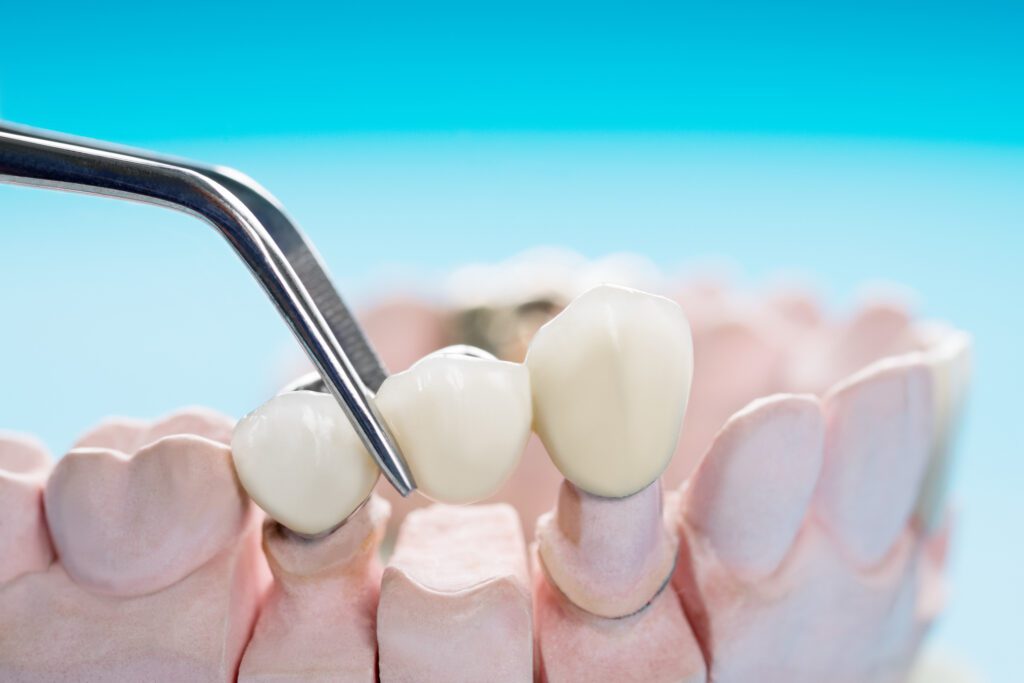A dental bridge is a natural-looking way to fill in gaps caused by missing teeth. Custom-made for each patient, these bridges are designed to blend in with your natural smile. We can create your custom dental bridge in our Arlington, TX office to replace one or more missing teeth.
Bridges restore the shape of your teeth and help maintain the proper bite between your upper and lower teeth. A traditional bridge has two crowns on either side of the gap, with a fake tooth in between. If you need to replace several teeth in a row, bridges can also be supported by dental implants. Our Arlington office offers other restorative options for restoring missing teeth as well.

Dental Bridges in Arlington, TX
Bridges can be supported by crowns or implants. A traditional bridge replaces one or more missing teeth, using crowns on each side of the gap for support. Crowns cover the natural teeth on either side of the gap to keep the bridge in place.
Dental implants can also support bridges. These are small titanium posts placed in the jawbone, acting like replacement tooth roots. Implant-supported bridges are strong and stable, allowing you to eat and speak comfortably.
While getting implants takes longer, they provide more lasting support. Whether you choose a traditional bridge or an implant-supported bridge, we will work with you to find the best option for your needs.
Benefits of Implant Bridges
If you’re missing one or more teeth, an implant-supported bridge can be a great solution. Unlike traditional bridges that rely on neighboring teeth for support, implant bridges are anchored by small titanium posts that act like artificial tooth roots. This makes them stronger and longer-lasting. Here’s how they can help:
- A More Natural Smile: Gaps in your smile can make you feel self-conscious. A custom-made bridge fills those spaces with replacement teeth that blend in with your natural ones. The dental lab carefully matches the shape, size, and color so your smile looks complete and natural.
- Clearer Speech: Missing teeth can sometimes cause slurring or whistling sounds when you talk. A bridge fills in the gaps, helping your tongue and lips move naturally so you can speak more clearly. Since implant bridges are securely anchored, they won’t slip like removable dentures might.
- Stronger Support for Your Teeth: When a tooth is missing, the teeth around it can slowly shift out of place, causing bite problems or even jaw pain. A bridge keeps your remaining teeth properly aligned. Implant bridges go a step further by replacing the missing tooth roots, which helps preserve your jawbone and prevent future shifting.
- Better Chewing and Comfort: Missing teeth make it harder to eat foods you love, like crunchy vegetables or chewy meats. A bridge restores your ability to bite and chew comfortably. Because implant bridges are anchored into your jawbone (just like real teeth), they provide even more strength and stability than traditional bridges. This means you can enjoy your favorite foods without worry.
- Long-Term Durability: With proper care, implant-supported bridges can last many years. They often last much longer than traditional bridges. Since they don’t rely on neighboring teeth for support, they also help protect your remaining natural teeth from extra wear and tear.
The Dental Bridge Process in Arlington, TX
The process begins with a full exam of your teeth and gums. If there are any issues, like tooth decay or gum disease, we will treat those first. Sometimes, this may involve extractions, root canals, fillings, or gum treatments.
To start the bridge treatment, we will numb the area and prepare the teeth next to the gap by shaping them for crowns. After that, we take impressions of your teeth to send to a lab.
The lab will create a custom bridge based on these measurements. Once ready, the bridge will be secured in place by your dentist, making sure it fits well and feels comfortable.
Implant Bridge
If you prefer to secure your bridge with implants, we will first check if you’re a good candidate. We’ll recommend any needed treatments to make sure your mouth is healthy. Like other bridge treatments, it’s important to have healthy teeth and gums.
If you don’t have enough jawbone to support the implants, we may suggest a bone graft. This involves using healthy tissue from a donor or another part of your mouth.
When you’re ready, we will work with an oral surgeon to place the implants. We’ll take X-rays to find the best spots for the posts. The surgeon will place the implants to make sure they are fully supported by the bone and provide a strong foundation for your bridge.
After surgery, it takes about 3 to 6 months for the implants to heal. During this time, called osseointegration, the bone will grow around the posts. Once you’re healed, we will attach abutments that connect the implants to your bridge. After your gums heal from the abutments, you will return to our office for your final bridge.
How to Care for a Dental Bridge
Once you get your final dental bridge in our Arlington, TX office, follow these tips to help it last:
- Brush and floss daily: Brush at least twice a day and floss to prevent bacteria buildup around your bridge. Use a soft toothbrush to gently clean around it. You may find threaded floss or a water flosser helpful, especially if you have implants.
- Regular dental visits: Regular checkups and cleanings are key to keeping your bridge in good shape. Our dentist can spot problems early and provide thorough cleanings to prevent decay and gum disease.
- Avoid sticky or hard foods: Foods that are sticky or hard could damage your bridge. Stick to softer foods, at least at first. If you have implants, you’ll find it easier to eat harder foods over time as the implants provide strong support.
Restore Missing Teeth Today
Need to replace several missing teeth? Get a custom dental bridge in Arlington, TX for a complete smile. Call our office at 817-261-4982 to schedule a consultation or book an appointment online. Have questions about dental bridges? We’re happy to answer them at your next visit!
